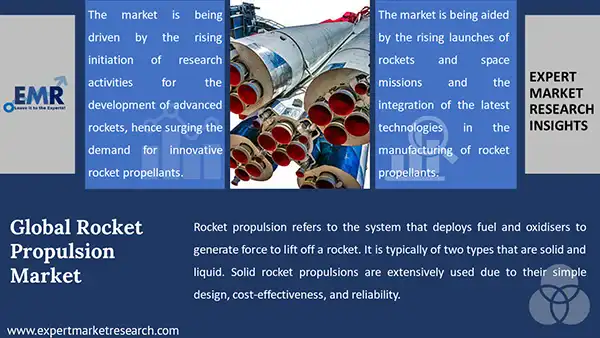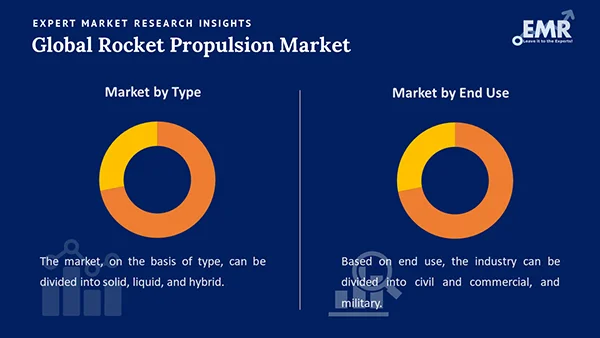
Consumer Insights
Uncover trends and behaviors shaping consumer choices today
Procurement Insights
Optimize your sourcing strategy with key market data
Industry Stats
Stay ahead with the latest trends and market analysis.
The global rocket propulsion market attained a value of about USD 6.84 Billion in 2025. The market is further expected to grow in the forecast period of 2026-2035 at a CAGR of 8.70% to reach nearly USD 15.75 Billion by 2035.
Base Year
Historical Period
Forecast Period
Compound Annual Growth Rate
8.7%
Value in USD Billion
2026-2035
*this image is indicative*
The market for rocket propulsion is being aided by the increasing launches of rockets by governments organisations and various companies to enhance the scientific capabilities of their countries. For instance, Russia, in December 2020, launched Angara A5 heavy-lift rocket that does not utilise toxic and aggressive propellants to enhance environmental friendliness. Moreover, the increasing investments in miniature spacecraft technologies are surging the demand for small rocket propulsions. The market is also being augmented by the growing demand for alternative fuels for the propulsion of rockets, which is leading to the development of electricity-based rocket propulsion. For instance, in October 2020, NASA introduced an in-space electric propulsion system to enhance the cost-effectiveness and sustainability of rocket propulsion.

Read more about this report - REQUEST FREE SAMPLE COPY IN PDF
Technological advancements and innovations are leading to the development of advanced rocket propulsion, which is propelling the market growth. The integration of artificial intelligence (AI) and machine learning to boost the productivity and capabilities of rocket propulsion during manufacturing is increasing the cost-effectiveness of rocket propulsions. Moreover, the use of such technologies is also optimising the structure and design of the engine of the rocket, hence aiding in the efficient development of fuel-efficient engines, which is providing impetus to the market growth.

Read more about this report - REQUEST FREE SAMPLE COPY IN PDF
Rocket propulsion refers to the system that deploys fuel and oxidisers to generate force to lift off a rocket. It is typically of two types that are solid and liquid. Solid rocket propulsions are extensively used due to their simple design, cost-effectiveness, and reliability.
The major types of rocket propulsion are:
The market can be broadly categorised on the basis of its end uses into:
The EMR report looks into the regional markets of rocket propulsion like:
The development of innovative rockets for diverse and advanced uses is propelling the market growth of rocket propulsion. As the demand for lightweight rockets with enhanced performance is surging, innovative rocket propulsions are being deployed to boost rocket-engine efficiency. The development of green fuels, deploying hydrogen and oxygen, that can increase the signal strength of the rocket is further bolstering the growth of the rocket propulsion industry. In addition, the deployment of innovative technologies in the manufacturing process is bolstering the production of innovative rockets, which is anticipated to augment the market growth in the forecast period.
The initiation of various research activities to develop environmentally friendly space propellants to boost sustainable growth is expected to propel the market growth. The deployment of such propellants is also expected to enhance cost-effectiveness, ease of handling, and safety, especially for reusable vehicles and low-cost micro-satellite missions. Moreover, the trend of 3D printing is projected to rapidly and efficiently manufacture heat barriers, injectors, combustion chambers, and mounting interfaces, among others. The introduction of various favourable initiatives by aeronautics and space organisations like NASA’s Green Propellent Infusion Mission (GPIM) is predicted to provide further impetus to the industry growth in upcoming years.
The report presents a detailed analysis of the following key players in the global rocket propulsion market, looking into their capacity, market shares, and latest developments like capacity expansions, plant turnarounds, and mergers and acquisitions:
The comprehensive report looks into the macro and micro aspects of the industry. The EMR report gives an in-depth insight into the market by providing a SWOT analysis as well as an analysis of Porter’s Five Forces model.




*While we strive to always give you current and accurate information, the numbers depicted on the website are indicative and may differ from the actual numbers in the main report. At Expert Market Research, we aim to bring you the latest insights and trends in the market. Using our analyses and forecasts, stakeholders can understand the market dynamics, navigate challenges, and capitalize on opportunities to make data-driven strategic decisions.*
Get in touch with us for a customized solution tailored to your unique requirements and save upto 35%!
In 2025, the global rocket propulsion market attained a value of nearly USD 6.84 Billion.
The market is projected to grow at a CAGR of 8.70% between 2026 and 2035.
The market is estimated to witness a healthy growth in the forecast period of 2026-2035 to reach about USD 15.75 Billion by 2035.
The major market drivers include the surging launches of rockets and space missions and the integration of the latest technologies in the manufacturing of rocket propellants.
The key trends propelling the market growth are the rising demand for eco-friendly rocket propellants, the growing trend of 3D printing, and the development of innovative rocket propellants.
The major regions in the market are North America, Latin America, the Middle East and Africa, Europe, and the Asia Pacific.
The major types of rocket propulsion in the market are solid, liquid, and hybrid.
The significant end uses in the market are civil and commercial, and military.
The major players in the market are Northrop Grumman Corporation, Antrix Corporation Limited, Mitsubishi Heavy Industries Ltd, Safran SA, and Space Exploration Technologies Corp., among others.
Explore our key highlights of the report and gain a concise overview of key findings, trends, and actionable insights that will empower your strategic decisions.
| REPORT FEATURES | DETAILS |
| Base Year | 2025 |
| Historical Period | 2019-2025 |
| Forecast Period | 2026-2035 |
| Scope of the Report |
Historical and Forecast Trends, Industry Drivers and Constraints, Historical and Forecast Market Analysis by Segment:
|
| Breakup by Type |
|
| Breakup by End Use |
|
| Breakup by Region |
|
| Market Dynamics |
|
| Competitive Landscape |
|
| Companies Covered |
|
| Report Price and Purchase Option | Explore our purchase options that are best suited to your resources and industry needs. |
| Delivery Format | Delivered as an attached PDF and Excel through email, with an option of receiving an editable PPT, according to the purchase option. |
Datasheet
One User
USD 2,499
USD 2,249
tax inclusive*
Single User License
One User
USD 3,999
USD 3,599
tax inclusive*
Five User License
Five User
USD 4,999
USD 4,249
tax inclusive*
Corporate License
Unlimited Users
USD 5,999
USD 5,099
tax inclusive*
*Please note that the prices mentioned below are starting prices for each bundle type. Kindly contact our team for further details.*
Flash Bundle
Small Business Bundle
Growth Bundle
Enterprise Bundle
*Please note that the prices mentioned below are starting prices for each bundle type. Kindly contact our team for further details.*
Flash Bundle
Number of Reports: 3
20%
tax inclusive*
Small Business Bundle
Number of Reports: 5
25%
tax inclusive*
Growth Bundle
Number of Reports: 8
30%
tax inclusive*
Enterprise Bundle
Number of Reports: 10
35%
tax inclusive*
How To Order

Select License Type
Choose the right license for your needs and access rights.

Click on ‘Buy Now’
Add the report to your cart with one click and proceed to register.

Select Mode of Payment
Choose a payment option for a secure checkout. You will be redirected accordingly.
Gain insights to stay ahead and seize opportunities.

Get insights & trends for a competitive edge.

Track prices with detailed trend reports.

Analyse trade data for supply chain insights.

Leverage cost reports for smart savings

Enhance supply chain with partnerships.

Connect For More Information
Our expert team of analysts will offer full support and resolve any queries regarding the report, before and after the purchase.
Our expert team of analysts will offer full support and resolve any queries regarding the report, before and after the purchase.
We employ meticulous research methods, blending advanced analytics and expert insights to deliver accurate, actionable industry intelligence, staying ahead of competitors.
Our skilled analysts offer unparalleled competitive advantage with detailed insights on current and emerging markets, ensuring your strategic edge.
We offer an in-depth yet simplified presentation of industry insights and analysis to meet your specific requirements effectively.
Share